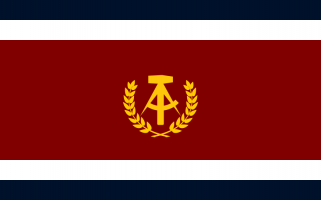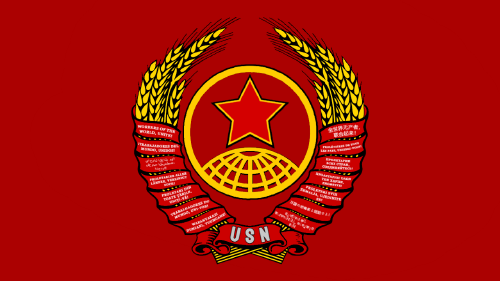| National Factbook |
| Flag: |

|
| Nation Name: |
Sarussia |
| Leader Name: |
Jan Dijken |
| Currency: |

Euro |
| National Animal: |

Shark |
| History: |
Rise of Sarussia
Out of desperation and ideology, a coalition of survivors — including leftist activists, stranded sailors, and disillusioned workers — found the People’s Council of Sarussia (the name “Sarussia” derived from an old Frisian word for “salt” combined with “Russia,” reflecting its socialist aspirations).
By 2060, Borkum is formally proclaimed the People’s Republic of Sarussia, a socialist state with:
A planned economy based on fishing, seaweed cultivation, offshore wind energy, and scavenging from the mainland ruins.
Collective farms established on reclaimed salt marshes and protected dune areas.
A militia-style defense force using scavenged NATO and Russian weapons.
Society & Culture
Isolationist but resilient: Cut off from the mainland, Sarussia develops a culture of self-reliance and suspicion of outsiders.
Maritime Communalism: Fishing fleets are run collectively, and offshore wind farms are managed by cooperatives.
Political Life: The island is ruled by the Supreme People’s Council, a rotating body of delegates from fishing communes, worker brigades, and military units.
Propaganda & Identity: The government presents Sarussia as “the last true workers’ state in Europe,” positioning itself as a beacon of socialist survival after capitalist collapse.
International Standing
Enemies & Neighbors: Postwar Britain and Scandinavia view Sarussia as a nuisance — small, but radical and unpredictable.
Strategic Value: Its location in the North Sea gives it surprising leverage in shipping lanes. Rumors persist of hidden submarine bases in old NATO bunkers beneath the dunes.
Trade & Smuggling: Despite its ideology, Sarussia quietly trades fish, wind power, and salvaged technology for medicine and machine parts through smugglers.
|
| Geography |
| Continent: |
Europe |
| Land Area: |
8,046.70 sq. km |
| Terrain: |
Flat & Low-Lying: The island is generally very flat, with its highest natural elevations being only a few meters above sea level.
Sand Dunes: Extensive dune systems dominate much of the landscape, some covered with grasses and shrubs to stabilize them.
Wide Beaches: The western and northern shores feature broad sandy beaches, ideal for swimming and recreation.
Salt Marshes & Mudflats: On the eastern side, facing the Wadden Sea, you find tidal flats and salt marshes, part of the UNESCO World Heritage Wadden Sea ecosystem.
Heath & Meadows: Inland, the dunes transition into heathland, meadows, and small forested areas planted to reduce wind erosion.
Man-Made Features: Dikes and embankments protect the island’s settlements from flooding. |
| Highest Peak: |
,
19 meters
|
| Lowest Valley: |
,
0 meters
|
| Climate: |
Mild Winters: Temperatures rarely drop very low due to the moderating effect of the North Sea. Frost and snow are uncommon but can occur occasionally.
Cool Summers: Summers are relatively cool, with average highs usually in the low 20s °C (around 68–72 °F). Heat waves are rare.
High Humidity & Frequent Rain: Precipitation is evenly distributed throughout the year, often as showers and sometimes accompanied by strong winds.
Windy Conditions: The island is known for frequent and sometimes strong westerly winds, making it popular for windsurfing and kitesurfing.
Moderate Sunshine: Cloud cover is frequent, but the island enjoys more sunshine hours.
Healthy Sea Air: Sarussia has a reputation for clean, pollen-poor air enriched with iodine and salty aerosols, which has made it a traditional health resort.
In short: cool, humid, and windy with mild seasonal contrasts, very typical of a North Sea island. |
| People & Society |
| Population: |
530,320 people |
| Demonym: |
Sarussian |
| Demonym Plural: |
Sarussians |
| Ethnic Groups: |
Germanic - 100.0%
European - 100.0% |
| Languages: |
Sarussian - 100.0%
English - 80.0%
German - 65.0% |
| Religions: |
None - 0.0%
None - 0.0%
None - 0.0% |
| Health |
| Life Expectancy: |
81 years |
| Obesity: |
10% |
| Alcohol Users: |
0% |
| Tobacco Users: |
40% |
| Cannabis Users: |
0% |
| Hard Drug Users: |
0% |
| Economy |
| Description: |
The People’s Republic of Sarussia maintains a developing yet resilient economy, balancing socialist ideals with pragmatic engagement in regional trade.
Population & Labor Force:
With a population of 114,204, Sarussia relies heavily on communal labor systems, with fishing, maritime trade, renewable energy, and small-scale manufacturing forming the backbone of employment.
Land & Density:
The nation covers 1,250 square miles, yielding a modest population density of about 91 people per square mile. This relatively low density provides space for collective farms, wind farms, and fishing cooperatives to thrive without overcrowding.
Gross Domestic Product (GDP):
Sarussia’s GDP stands at $507.5 million, producing a GDP per capita of $4,444. This places the republic within the lower-middle income range globally, though the distribution is more equal than in many capitalist nations due to collectivist policies.
Gross National Income (GNI):
With a GNI of $452 million, Sarussia’s economy shows signs of both self-reliance and external engagement, as smuggling and regional trade supplement official economic activity.
Infrastructure:
Infrastructure is rated at 1,260 points, reflecting functional but modest transport systems, renewable energy facilities, and defensive installations. Development is focused on durability and self-sufficiency rather than luxury.
Economic Policies:
Officially labeled as “Moderate”, Sarussia’s policies mix centralized planning with limited market mechanisms. Worker cooperatives operate alongside state-owned enterprises, while small-scale private trade is quietly tolerated in border regions and ports.
Currency:
The republic adopts the Euro for external trade, though internally it supplements with a local voucher and ration system to reduce dependence on foreign currency. |
| Average Yearly Income: |
$84.22 |
| Gross Domestic Product (GDP): |
$1,649,615,337.00 |
| GDP per Capita: |
$3,110.59 |
| Gross National Income (GNI): |
$1,396,816,310.00 |
| Industries: |
The industrial base of Sarussia is small but highly specialized, shaped by its island geography and socialist economic model.
Fishing & Maritime Processing – The largest sector, providing food security and exports. Fish canning, seaweed processing, and salt harvesting sustain both domestic needs and trade.
Renewable Energy – Offshore wind farms and tidal generators supply most of the nation’s electricity, making Sarussia nearly energy-independent.
Light Manufacturing – Small-scale factories produce ship components, fishing gear, tools, and basic consumer goods, often using scavenged or recycled materials.
Agricultural Processing – Communal farms and greenhouses support industries in food preservation, dairy, and grain milling.
Defense & Salvage – A unique sector tied to Sarussia’s survivalism: workshops refurbish old military equipment and salvage materials from mainland ruins for reuse. |
| Military |
| History: |
The People’s Armed Forces of Sarussia
The People’s Armed Forces (PAF) serve as the military branch of the People’s Republic of Sarussia. Though still in their infancy, the forces are steadily expanding in both size and organization, rooted in the republic’s commitment to defend its sovereignty and socialist ideals.
Structure:
People’s Army – The core land force, currently about 100 soldiers but slowly growing through recruitment and mandatory training programs. Soldiers are equipped with a mix of refurbished small arms and light vehicles.
People’s Navy – Consists of patrol boats and converted fishing vessels, tasked with coastal defense and securing Sarussia’s territorial waters.
People’s Airforce – A small, emerging branch, presently limited to drones and light aircraft, with future plans for expanded surveillance and defensive capabilities. |
| Soldiers: |
74,946 |
| Tanks: |
0 |
| Aircraft: |
360 |
| Ships: |
11 |
| Missiles: |
0 |
| Nuclear Weapons: |
0 |
| Last Updated: 08/18/2025 08:03 pm |















